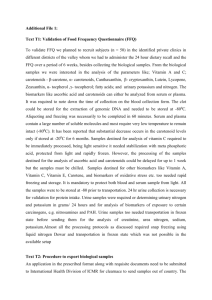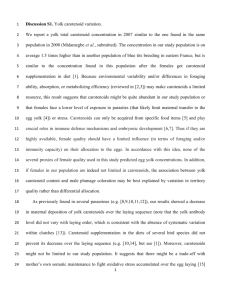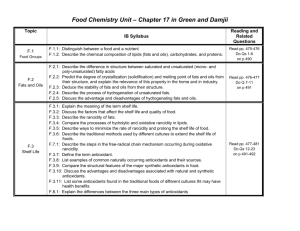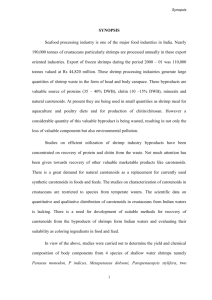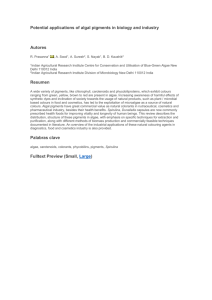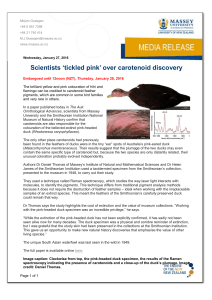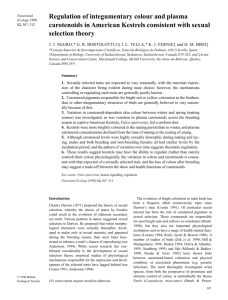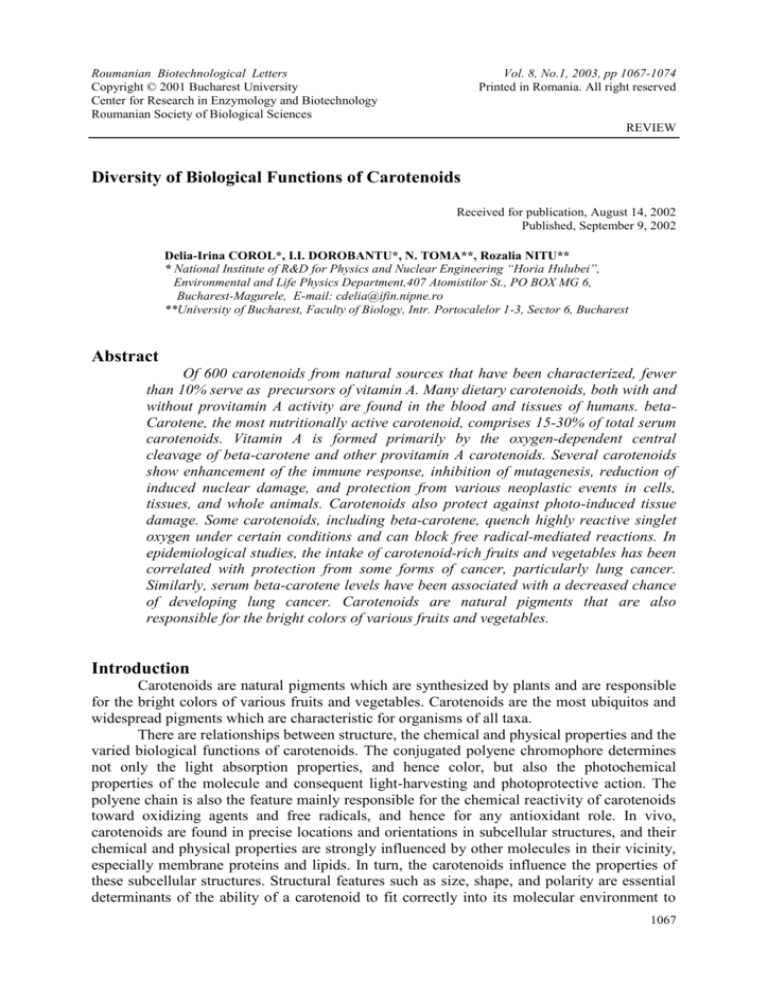
Roumanian Biotechnological Letters
Copyright © 2001 Bucharest University
Center for Research in Enzymology and Biotechnology
Roumanian Society of Biological Sciences
Vol. 8, No.1, 2003, pp 1067-1074
Printed in Romania. All right reserved
REVIEW
Diversity of Biological Functions of Carotenoids
Received for publication, August 14, 2002
Published, September 9, 2002
Delia-Irina COROL*, I.I. DOROBANTU*, N. TOMA**, Rozalia NITU**
* National Institute of R&D for Physics and Nuclear Engineering “Horia Hulubei”,
Environmental and Life Physics Department,407 Atomistilor St., PO BOX MG 6,
Bucharest-Magurele, E-mail: cdelia@ifin.nipne.ro
**University of Bucharest, Faculty of Biology, Intr. Portocalelor 1-3, Sector 6, Bucharest
Abstract
Of 600 carotenoids from natural sources that have been characterized, fewer
than 10% serve as precursors of vitamin A. Many dietary carotenoids, both with and
without provitamin A activity are found in the blood and tissues of humans. betaCarotene, the most nutritionally active carotenoid, comprises 15-30% of total serum
carotenoids. Vitamin A is formed primarily by the oxygen-dependent central
cleavage of beta-carotene and other provitamin A carotenoids. Several carotenoids
show enhancement of the immune response, inhibition of mutagenesis, reduction of
induced nuclear damage, and protection from various neoplastic events in cells,
tissues, and whole animals. Carotenoids also protect against photo-induced tissue
damage. Some carotenoids, including beta-carotene, quench highly reactive singlet
oxygen under certain conditions and can block free radical-mediated reactions. In
epidemiological studies, the intake of carotenoid-rich fruits and vegetables has been
correlated with protection from some forms of cancer, particularly lung cancer.
Similarly, serum beta-carotene levels have been associated with a decreased chance
of developing lung cancer. Carotenoids are natural pigments that are also
responsible for the bright colors of various fruits and vegetables.
Introduction
Carotenoids are natural pigments which are synthesized by plants and are responsible
for the bright colors of various fruits and vegetables. Carotenoids are the most ubiquitos and
widespread pigments which are characteristic for organisms of all taxa.
There are relationships between structure, the chemical and physical properties and the
varied biological functions of carotenoids. The conjugated polyene chromophore determines
not only the light absorption properties, and hence color, but also the photochemical
properties of the molecule and consequent light-harvesting and photoprotective action. The
polyene chain is also the feature mainly responsible for the chemical reactivity of carotenoids
toward oxidizing agents and free radicals, and hence for any antioxidant role. In vivo,
carotenoids are found in precise locations and orientations in subcellular structures, and their
chemical and physical properties are strongly influenced by other molecules in their vicinity,
especially membrane proteins and lipids. In turn, the carotenoids influence the properties of
these subcellular structures. Structural features such as size, shape, and polarity are essential
determinants of the ability of a carotenoid to fit correctly into its molecular environment to
1067
Delia-Irina COROL, I.I. DOROBANTU, N. TOMA, Rozalia NITU
allow it to function. Ability of carotenoids in modifying structure, properties, and stability of
cell membranes, and thus affecting molecular processes associated with these membranes,
may be an important aspect of their possible beneficial effects on human health.[2]
Of 600 carotenoids from natural sources that have been characterized, fewer than 10%
serve as precursors of vitamin A. Many dietary carotenoids, both with and without provitamin
A activity, are found in the blood and tissues of humans. beta-Carotene, the most nutritionally
active carotenoid, comprises 15-30% of total serum carotenoids. Vitamin A is formed
primarily by the oxygen-dependent central cleavage of beta-carotene and other provitamin A
carotenoids. Several carotenoids show enhancement of the immune response, inhibition of
mutagenesis, reduction of induced nuclear damage, and protection from various neoplastic
events in cells, tissues, and whole animals. Carotenoids also protect against photo-induced
tissue damage. Some carotenoids, including beta-carotene, quench highly reactive singlet
oxygen under certain conditions and can block free radical-mediated reactions. In
epidemiological studies, the intake of carotenoid-rich fruits and vegetables has been
correlated with protection from some forms of cancer, particularly lung cancer. Similarly,
serum beta-carotene levels have been associated with a decreased chance of developing lung
cancer. It must be stressed, however, that these epidemiological associations do not show
cause and effect. In this regard, long-term intervention trials with beta-carotene supplements
are in progress. Whatever the results of these trials, carotenoids clearly show biological
actions in animals distinct from their function as precursors of vitamin A.[1]
Table 1. Some of the biological functions of carotenoids.[24]
Structure
Properties
Functions
Polyene chain
electronic
ability for close-electron cloud mobility
range
energy light absorption
high reducing potential
transfer
(easily
oxidized
molecule)
transfer of absorbed photo-synthetic antenna
antioxidant defense via
light
energy to pigments
elimination
of
free
chlorophyll
(all photosynthetics)
radicals (bacteria, plants,
(all photosynthetics)
animals)
light reception in vision
(retinal in all animals)
triplet chlorophyll
quenching
(all photosynthetics)
coloration
-species/sex/social status
-masking (animals)
-attractive or repellent
(animals, plants)
singlet
oxygen
quenching
(O2photosynthetics)
chromophor in
bacteriorhodopsin
photosynthesis
(Halobacterium)
defense against NO2
nitrosative
action
(plants)
Mechanic
Rigidity
stereospecific
Stabilization
of
membrane fluidity
(bacteria,
mycoplasms,
fungi, mollusca)
animal
(retinoic
acid)
and plant
(abscisic
acid)
hormones
Stabilization and
defense of
caroteno-proteins
in skeleton
structures
(crustaceans,
mollusca,
echinoderms)
Defense of reserve
proteins in
molluscan and
crustaceans eggs
against proteases
light-protective
screening (shown in
microalgae)
selective light filtering in
retina (insects, birds)
metabolic activation via
heating (lake planktonic
crustaceans)
1068
Roum. Biotechnol. Lett., Vol. 8, No. 1, 1067-1074 (2003)
Diversity of Biological Functions of Carotenoids
Mechanical functions
The natural pigments carotenoids were first emerged in archaebacteria. Their function
in the oldest Earth organisms was that of lipids reinforcing bacterial cell membrane.
Carotenoidic molecules have an extremely rigid backbone due to the linear chain of 10-11
conjugates double bonds – the length corresponding to the thickness of the hydrophobic zone
of the membrane that they penetrate.[19] Their polyene structure is very hard to bend or twist.
Carotenoids decrease the fluidity of membrane, so their amounts control the stability
of that parameter, affecting all membrane functions. The membrane reinforcing function of
carotenoids is retained in mycoplasms, some fungi and animals. This is the main reason for
the colouration of flesh of many mollusca and ascidians (yellow-to-red colour). [11, 12, 21,
25]
It is known that carotenoids and proteins form complexes (carotenoproteins) which
are highly resistant to environmental action due to carotenoidic and protein parts.[26] In
molluscan and crustacean eggs, the major reserve of proteins are carotenoproteins, which are
not affected by proteases present in cytoplasm, because carotenoids defend the protein core
from digestion.
Subczynski W.K. et al. [23] have discovered, using a spin-label study, the effects of
polar carotenoids on dimyristoylphosphatidylcholine membranes. Spin labeling methods were
used to study the structure and dynamic properties of dimyristoylphosphatidylcholine
(DMPC) membranes as a function of temperature and the mole fraction of polar carotenoids.
The results in fluid phase membranes were as follows: (i) Dihydroxycarotenoids, zeaxanthin
and violaxanthin, increase order, decrease motional freedom and decrease the flexibility
gradient of alkyl chains of lipids. The activation energy of rotational diffusion of the 16doxylstearic acid spin label was about 35% less in the presence of 10 mol% of zeaxanthin. (ii)
Carotenoids increase the mobility of the polar headgroups of DMPC and increase water
accessibility in that region of membrane.(iii) Rigid and highly anisotropic molecules
dissolved in the DMPC membrane exhibit a bigger order of motion in the presence of polar
carotenoids . Carotenoids decrease the rate of reorientational motion of cholestane spin label
(CSL) and do not influence the rate of androstane spin label (ASL), probably due to the lack
of the isooctyl side chain. The abrupt changes of spin label motion observed at the main phase
transition of the DMPC bilayer are broadened and disappear at the presence of 10 mol% of
carotenoids. In gel phase membranes, polar carotenoids increase motional freedom of most of
the spin labels employed showing a regulatory effect of carotenoids on membrane fluidity.
Their results support the hypothesis that carotenoids regulate the membrane fluidity in
Procaryota as cholesterol does in Eucaryota. A model is proposed by these researchers to
explain these results in which intercalation of the rigid rod-like polar carotenoid molecules
into the membrane enhances extended trans-conformation of the alkyl chains, decreases free
space in the bilayer center, separate the phosphatidylcholine headgroups and decreases
interaction between them. [19]
Photosynthetic and antioxidant functions
Carotenoids function as accessory light-harvesting pigments in all plants due the polyene
chain of 9-11 double bonds which absorb light in the gap of chlorophyll absorption (420-500nm).
[22] The unique arrangement of molecular energy levels provided by polyene makes carotenoids
the only natural compounds capable of close-range excitation energy transfer:
from the carotenoid excited state (S1) to chlorophyll S1 in the light-harvesting complex,
this is how light energy caught by carotenoid is channeled to photosynthetic reactions;
from the triplet state of chlorophyll (a highly unstable state produced in photosynthesis
and resulting in destruction of that molecule) to triplet carotenoid;
Roum. Biotechnol. Lett., Vol. 8, No. 1, 1067-1074 (2003)
1069
Delia-Irina COROL, I.I. DOROBANTU, N. TOMA, Rozalia NITU
from the singlet state of oxygen to carotenoid triplet state.
In photosynthetic reactions of all photosynthetics take place the two latter processes,
absolutely vital for protection of reaction centre (RC) from photodamage. Carotenoids return
from triplet to ground state just dissipate the excessive energy as heat, possible due to the very
close range interactions inside the pigment-protein complex (RC or LHC-light harvesting
chlorophyll).[24]
It is known that only about 50 of total of 600 carotenoids have provitamin A activity.
Despite being one of the first vitamins to be discovered, the full range of biological activities
for vitamin A remains to be defined. Within the body, vitamin A can be found as retinol,
retinal and retinoic acid. Because all of these forms are toxic at high concentrations, they are
bound to proteins in the extracellular fluids and inside cells. Vitamin A is stored primarily as
long chain fatty esters and as provitamin carotenoids in the liver, kidney and adipose tissue.
The antioxidant activity of vitamin A and carotenoids is conferred by the hydrophobic chain
of polyene units that can quench singlet oxygen, neutralize thioyl radicals and combine with
and stabilize peroxyl radicals. In general, the longer the polyene chain, the greater the peroxyl
radical stabilizing ability. Because of their structures, vitamin A and carotenoids can
autoxidize when O2 tension increases, and thus are most effective antioxidants at low oxygen
tensions that are typical of physiological levels found in tissues.[18]
These compounds can theoretically participate in a biological antioxidant network.
Under physiological conditions, vitamin A esters are transported and stored in a lipid matrix
that contains other antioxidants, and retinol and its active metabolites are largely bound in
clefts of specific retinoid-binding proteins. Thus, vitamin A seems to be protected in vivo by
other antioxidants and proteins rather than protecting other molecules. Carotenoids are largely
distributed in lipoproteins, membranes, and the lipid phases of intracellular structures, usually
together with vitamin E. Carotenoids can interact with other antioxidants in vitro, but whether
they play similar significant roles in vivo is not clear.[16]
Much effort has been expended in evaluating the relative antioxidant potency of
carotenoid pigments in both in vitro and in vivo experiments. It is quite clear that in vitro,
carotenoids can inhibit the propagation of radical-initiated lipid peroxidation, and thus fulfill
the definition of antioxidants.
When it comes to in vivo systems, it has been much more difficult to obtain solid
experimental evidence that carotenoids are acting directly as biological antioxidants. In fact,
under nonphysiological circumstances, carotenoids may act as prooxidants.
These results can be modified by altering the oxidant stress, the cellular or subcellular
system, the type of animal, and environmental conditions, such as oxygen tension. Results of
this type raise the question as to whether it is still appropriate to group the carotenoids with
such antioxidant vitamins as vitamin E and vitamin C. Thus, the biological properties of the
carotenoids may be much more related to the products of the interaction of carotenoids with
oxidant stress, that is, such breakdown products as apocarotenoids and retinoids.[13]
Singlet molecular oxygen (1O2) has been shown to be generated in biological systems
and is capable of damaging proteins, lipids and DNA. The ability of some biological
antioxidants to quench 1O2 was studied by using singlet oxygen generated by the
thermodissociation of the endoperoxide of 3,3'-(1,4-naphthylidene) dipropionate (NDPO2).
The carotenoid lycopene was the most efficient 1O2 quencher (kq + kr = 31 x 10(9) M-1 s-1).
The singlet oxygen quenching ability decreased in the following order: lycopene, gammacarotene, astaxanthin, canthaxanthin, alpha-carotene, beta-carotene, bixin, zeaxanthin,
lutein, bilirubin, biliverdin, tocopherols and thiols. However, the compounds with low
quenching rate constants occur at higher levels in biological tissues. Thus, carotenoids may
contribute almost equally to the protection of tissues against the deleterious effects of 1O2.
The quenching abilities of carotenoids were mainly due to physical quenching.[9]
1070
Roum. Biotechnol. Lett., Vol. 8, No. 1, 1067-1074 (2003)
Diversity of Biological Functions of Carotenoids
Carotenoids as antioxidants have also been studied for their ability to prevent chronic
disease.
Various natural carotenoids were proven to have anticarcinogenic activity.
Epidemiological investigations have shown that cancer risk is inversely related to the
consumption of green and yellow vegetables and fruits. Since beta-carotene is present in
abundance in these vegetables and fruits, it has been investigated extensively as possible
cancer preventive agent. However, various carotenoids which co-exist with beta-carotene in
vegetables and fruits also have anti-carcinogenic activity. And some of them, such as alphacarotene, showed higher potency than beta-carotene to suppress experimental carcinogenesis.
Thus, we have carried out more extensive studies on cancer preventive activities of natural
carotenoids in foods; i.e., lutein, lycopene, zeaxanthin and beta-cryptoxanthin. Analysis of the
action mechanism of these natural carotenoids is now in progress, and some interesting results
have already obtained; for example, beta-cryptoxanthin was suggested to stimulate the
expression of RB gene, an anti-oncogene, and p73 gene, which is known as one of the p53related genes. Based on these results, multi-carotenoids (mixture of natural carotenoids)
seems to be of interest to evaluate its usefulness for practice in human cancer prevention.[14]
Epidemiologic studies have shown an inverse relationship between presence of
various cancers and dietary carotenoids or blood carotenoid levels. However, three out of four
intervention trials using high dose beta-carotene supplements did not show protective effects
against cancer or cardiovascular disease. Rather, the high risk population (smokers and
asbestos workers) in these intervention trials showed an increase in cancer and angina cases. It
appears that carotenoids (including beta-carotene) can promote health when taken at dietary
levels, but may have adverse effects when taken in high dose by subjects who smoke or who
have been exposed to asbestos.
It will be the task of ongoing and future studies to define the populations that can
benefit from carotenoids and to define the proper doses, lengths of treatment, and whether
mixtures, rather than single carotenoids (e.g. beta-carotene) are more advantageous.[17]
Recent evidence has shown vitamin A, carotenoids and provitamin A carotenoids can
be effective antioxidants for inhibiting the development of heart disease. Although there is
considerable discrepancy in the results from studies of humans regarding this relationship,
carefully controlled experimental studies continue to indicate that these compounds are
effective for mitigating and defending against many forms of cardiovascular disease. More
work, especially concerning the relevance of how tissue concentrations, rather than plasma
levels, relate to the progression of tissue damage in heart disease is required.[18]
Despite a large number of studies demonstrating protection by carotenoids, the
characteristics that render a given carotenoid effective and the relative efficiency of the
individual carotenoids are not known. Moreover, dose-response and pharmacokinetic
relationships remain virtually unexplored. Research to uncover mechanisms of protection by
carotenoids is, for technical reasons, painfully slow. Epidemiological studies reveal
associations but not cause and effect. To explore cause and effect, intervention trials are
underway, hampered by the paucity of data regarding optimal choice of carotenoid, dosage,
and regimen. The in vitro test systems that would provide this information are not available
because the molecular sites relevant to the chemopreventive action of carotenoids are obscure.
Each of these problems has a solution, but not a simple one. Until these are resolved, blanket
recommendations regarding supplementation will remain problematic.[8]
Roum. Biotechnol. Lett., Vol. 8, No. 1, 1067-1074 (2003)
1071
Delia-Irina COROL, I.I. DOROBANTU, N. TOMA, Rozalia NITU
Vision
Carotenoids represent the only natural source where from men and and animals can
synthetize vitamin A, which have an important biochemical role in human and animal
organisms. The oxidized half of several careotenoids, i.e. the retinals, are receptor molecules
in eyes of all animals. Retinals, complexed with the protein opsin, isomerize upon absorbing
light quants, causing change of conformation of the whole rhodopsin, thus launching the
further cascade of reactions lead to nerve excitation. This process very much resembles the
light reception in ancient bacteriorhodopsin photosynthesis. Retinal, complexed with three
different types of opsin, can absorb light of different wavelenghts – this is the base for colour
vision in mammals. [24]
Communicative coloration
Light-absorption within visible range is used for for the most spectacular function of
carotenoids – communicative species-specific coloration of plants and animals. Coloration of
plants in many cases are due to antocyans, in animals primarly by melanins, but carotenoids
have roles in really bright coloration of animals and plants. There are: [24]
species and sex specific coloration for the animals of the same species to recognize each
other;
sex/social status coloration (some corals change their color pattern due carotenoids, as a
sign of changed sex and social status);
masking coloration (chameleon);
attractive coloration (flowers and fruits);
warning coloration (coral aspid);
pigmentation of green microalga Haematococcus pluvialis, which accumulates large
amounts of carotenoids astaxanthin in cytoplasm under high light. This pigmentation is
for the screening of chloroplasts from excessive light;
carotenoids serve for rising body temperature by absorption of solar radiation and
dissipation of the energy as heat (planktonic copepodes in temperate lakes).[3]
Stereospecific functions
Carotenoids can be attacked enzymatically at almost every position in the molecule.
On the other hand, under dark nonoxidative conditions, they can be very stable. Thus, the
precise chemical and biological environment is of crucial importance in determining whether,
and how, they are transformed. Three important biologically active derivatives of carotenoids,
vitamin A, trisporic acid and abscisic acid, all of which serve as hormones in appropriate
cells, are, or can be, formed from precursor carotenoids. Highly active forms of all three
hormones are 9-cis isomers. In all cases, the products are involved both in light-induced
reactions as well as in cellular differentiation, often related to sexual maturation. Each of
these hormones is formed by an initial dioxygenase attack on the central conjugated chain of
carotenoids followed by a series of specific reactions. Indeed, when various carotenoids of
different structure are studied in humans, each shows a characteristic, if not unique, set of
metabolites. Thus, generalizations about carotenoid metabolism must be constrained by
precise metabolic information about given compounds. In dealing with the manifold
biological activities of carotenoids, it is useful to categorize them as functions, actions or
associations. In the hope of gaining greater insight into the relationship between carotenoids,
health and longevity, these distinctions should be helpful. [15]
Retinoic acid (oxidized half of beta-carotene molecule) in mammals is a hormone
regulating epidermal growth [20], abscisic acid (modified part of neoxanthin) is one of hrowth
1072
Roum. Biotechnol. Lett., Vol. 8, No. 1, 1067-1074 (2003)
Diversity of Biological Functions of Carotenoids
hormones.[10] These functions are not based on the rigidity of carotenoid molecules or their
unique electronic properties. The configuration of molecule is a key to the receptor lock.
Other functions
More recently, research interests on carotenoids have been revived, largely because of
their immunomodulatory activities in humans and animals. These carotenoids enhance
lymphocyte blastogenesis, increase the population of specific lymphocyte subsets, increase
lymphocyte cytotoxic activity, and stimulate the production of various cytokines. In addition,
carotenoids also stimulate the phagocytic and bacteria-killing ability of blood neutrophils and
peritoneal macrophages. The action of these carotenoids is widely accepted to be independent
of their provitamin A activity. The immunostimulatory action of carotenoids may be
translated into improved health, including mammary and reproductive health in dairy cattle.
More studies are needed to establish fully the beneficial effects of supplementation of
different carotenoids on the health of dairy cattle. Furthermore, studies on carotenoids other
than beta-carotene are needed. [4]
Zhao W et. al [27] have studied the effect of carotenoids on the respiratory burst of rat
peritoneal macrophages. The effect of four carotenoids (beta-carotene, lutein, bixin and
canthaxanthin) on the respiratory burst of rat peritoneal macrophages was investigated. The
results obtained showed that carotenoids suppressed the luminol-dependent
chemiluminescence generated from PMA-stimulated macrophages at the beginning and after
2 min of the stimulation. Canthaxanthin and bixin had higher suppressive activity than betacarotene and lutein. The changes in absorption spectra of carotenoids showed that the
absorption by carotenoids was diminished during the stimulation of macrophages by PMA
and their absorption peaks were either further diminished or blue-shifted after addition of Larginine to the system, indicating that the carotenoids were consumed and converted to new
compounds during the two processes. By using cell-free systems, it was found that
carotenoids could scavenge superoxide anion generated by xanthine/xanthine oxidase system.
Their ability to scavenge superoxide anion decreased in the order of canthaxanthin > bixin >
lutein > beta-carotene. Canthaxanthin also showed the scavenging effect on superoxide anion
generated from irradiation of riboflavin. The hydroxyl radical scavenging activity of
carotenoids was investigated in the reaction system of Fe2+ and H2O2. There was little
difference among their activities. The reaction between carotenoids and nitric oxide led to the
decreasing absorption between 400 and 540 nm and the concomitant appearance of the new
absorption peaks between 330 and 395 nm. Bleaching of beta-carotene, bixin and
canthaxanthin by peroxynitrite resulted in the increasing absorption between 290 and 365 nm
and the diminishing absorption between 400 and 500 nm. But the increasing absorption
between 280 and 490 nm was observed in bleaching of lutein by peroxynitrite. Carotenoids
inhibited thiobarbituric acid-reactive substance (TBARS) formation in AAPH-induced lipid
peroxidation of PC liposomes in air. The results suggest that the suppressive effect of
carotenoids on the respiratory burst of macrophages may be just a way by which carotenoids
in vivo protect host cells and tissues from harmful effects of oxygen metabolites
overproduced by macrophages and enhance the generation of specific immune responses. [27]
Conclusion
The overview of the diversity of carotenoids’ biological functions shows that the
general structure of the carotenoid molecule, originally evolved for membrane-reinforcement
in archaebacteria, remained practically unchanged in the great diversity of organisms and
functions. Carotenoids proved to be tailor-made for many roles, some of which are of vital
importance – like their protective function in photosynthetic reaction centers.
Roum. Biotechnol. Lett., Vol. 8, No. 1, 1067-1074 (2003)
1073
Delia-Irina COROL, I.I. DOROBANTU, N. TOMA, Rozalia NITU
In addition to their roles as precursors of retinol and retinoids, carotenoids have
distinct functions of their own in animals and humans. In vitro they are antioxidants with a
broad range of potencies.
The biological functions of carotenoids are not entirely known, this might be the
object of the further studies of the researchers.
References
Bendich, A., Olson, J.A., – FASEB J., 3(1), 927-932 (1989).
Britton, G., – FASEB J., 9(1), 551-558 (1995).
Byron, E.A., – Proc. Natl. Acad. Sci. USA, 78, 1765-1767 (1981).
Chew, B.P., – J. Dairy Sci., 76, 2804-2811 (1993).
Corol, D.I., Toma, N., Dorobantu, I.I., – Progrese in Biotehnologie, Ed. Ars Docendi,
136-162 (2001).
6. Corol, D.I., Toma, N., Dorobantu, I.I., – Progrese in Biotehnologie, Ed. Ars Docendi,
204-231 (2001).
7. Corol, D.I., Toma, N., Dorobantu, I.I., – Roum. Biotechnol. Lett., 6(6), 493-500 (2001).
8. Davison, A., Rousseau, E., Dunn, B., – Can. J. Physiol. Pharmacol., 71, 732-745 (1993).
9. Di Mascio, P., Devasagayam, T.P., Kaiser, S., Sies, H., – Biochem. Soc. Trans., 18, 10541056 (1990).
10. Goodwin, T.W., – The Biochemistry of Carotenoids. 1. Plants, Chapman and Hall, N.Y.
(1980).
11. Hsiao, K.C., Moller, I.M., – Physiol. Plant., 62, 167-174 (1984).
12. Huang, L., Huang, A., – Biochim. Biophys. Acta, 352, 361-370 (1974).
13. Krinsky, N.I., – Ann. N.Y. Acad. Sci., 854, 443-447 (1998).
14. Nishino, H., Tokuda, H., Murakoshi, M., Satomi, Y., Masuda, M., Onozuka, M.,
Yamaguchi, S., Takayasu, J., Tsuruta, J., Okuda, M., Khachik, F., Narisawa, T.,
Takasuka, N., Yano, M., – Biofactors, 13, 89-94 (2000).
15. Olson, J.A., – Ann. N.Y. Acad. Sci., 691, 156-166 (1993).
16. Olson, J.A., – J. Nutr. Sci. Vitaminol. (Tokyo), 39 Suppl., 57-65 (1993).
17. Paiva, S.A., Russell, R.M., – J. Am. Coll. Nutr., 18, 426-433 (1999).
18. Palace, V.P., Khaper, N., Qin, Q., Singal, P.K., – Free Radic. Biol. Med., 26, 746-761
(1999).
19. Rohmer, M., Bouvier, P., Ourisson, G., – Proc. Natl. Acad. Sci. USA, 76, 847-851 (1979).
20. Ross, A.C., Ternus, M.E., – J. American Dietic. Assoc., 93, 1285-1290 (1993).
21. Rottem, S., Markowitz O., – J. Bacteriol., 140, 944-948 (1979).
22. Siefermann-Harms, D., – Biochem. Biophys. Acta, 811, 325-355 (1985).
23. Subczynski, W.K., Markowska, E., Gruszecki, W.I., Sielewiesiuk, J., – Biochem. Biophys.
Acta, 1105, 97-108 (1992).
24. Vershinin, A., – BioFactors, 10, 99-104 (1999).
25. Vershinin, A., – Comp. Biochem. Physiol., 107B, 63-72 (1996).
26. Zagalsky, P.F., Eliopulos, E.E., – Comp. Biochem. Physiol., 97B, 1-18 (1990).
27. Zhao, W., Han, Y., Zhao, B., Hirota, S., Hou, J., Xin, W., – Biochem. Biophys. Acta,
1381, 77-88 (1998).
1.
2.
3.
4.
5.
1074
Roum. Biotechnol. Lett., Vol. 8, No. 1, 1067-1074 (2003)

